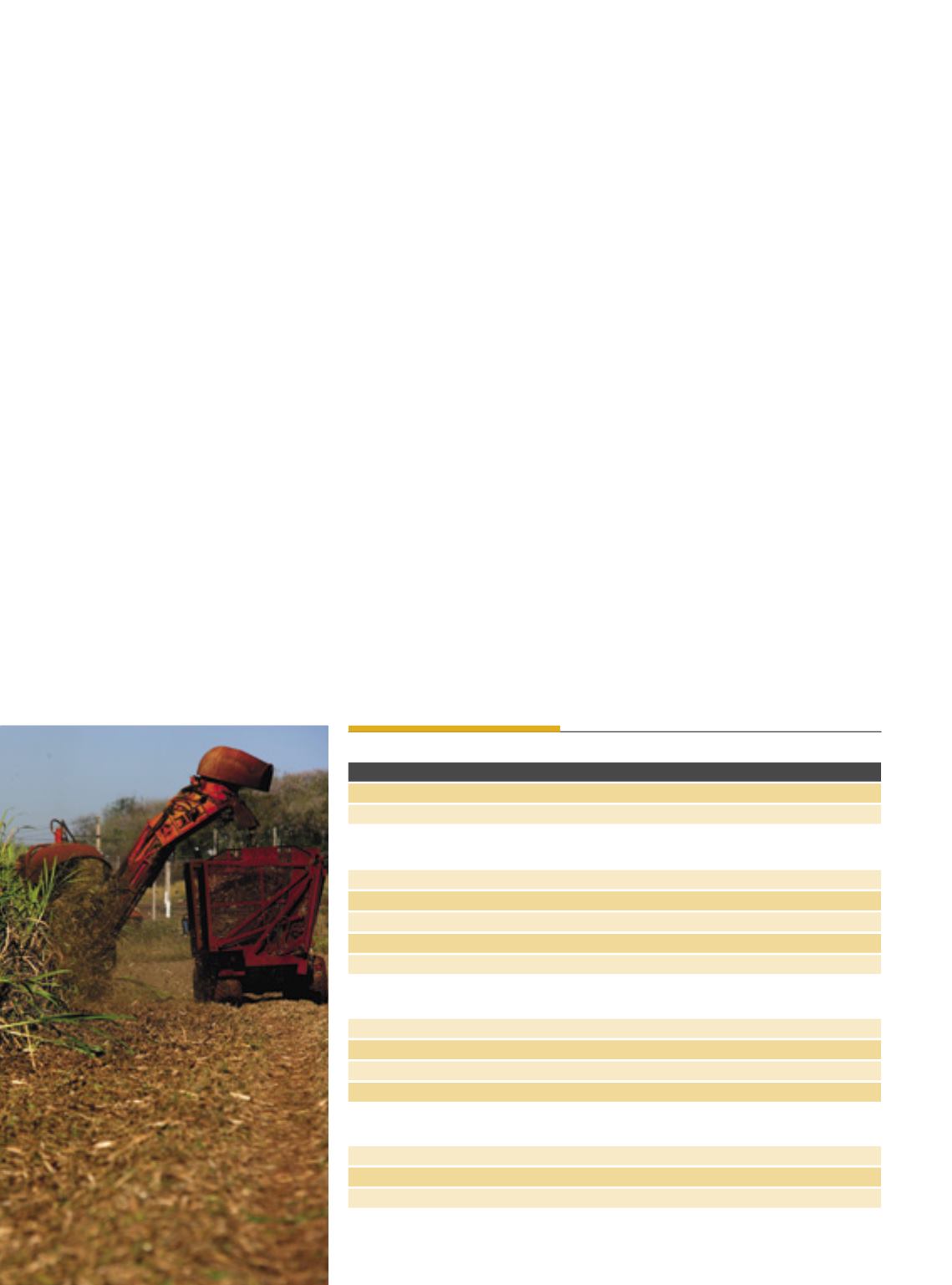
A
fter harvesting the biggest sug-
arcane area in the 2016/17
growing season, Brazil, leading
world producer, experiences a
3.4 percent drop in the 2017/18
crop year, which will equally have a propor-
tional influence on the production of the
crop. However, as far as the supply of sugar
goes, of which the Country is the leading ex-
porter, there shouldbe some increase in the
current season, but somewhat below the
value of the previous year. In themeantime,
another byproduct of sugarcane, ethanol,
though still on a downward trend, showed
some reaction in late 2017.
These numbers were released by the Na-
tional Food Supply Agency (Conab), of the
Ministry of Agriculture, Livestock and Food
Supply (Mapa), in its third sugarcane crop sur-
vey of the productive 2017/18 period (from
Smaller but
sweeter
crop
Sugarcanemilling inBrazil, biggest global producer,
should experience a reduction in the 2017/18
growing season, but destination for sugar is on the rise
April toMarch). Oneof the reasonsblamed for
thesmallerplantedareaisthefactthat“many
farmersquitplantingsugarcanebecausetheir
fields were located far away from the produc-
tion units, particularly where mechanization
isunviable”.Otherreasonsincludecompanies
thathavefiledforbankruptcy,sugarpricefluc-
tuations and previous seasons adversely af-
fectedbybadweatherconditions.
In the current season, now reaching its fi-
nal stage, climate conditions were considered
satisfactory up to early December 2017 in the
main sugarcane producing region (Center-
South),while thecrop in theNorthandNorth-
east was making a good recovery. This paved
the way for a slight increase in productivity,
around 0.2 percent, but still a long way from
the levels at the endof thepast decade. In the
evaluationof thegovernment agency, theage
ofthesugarcanefieldsmighthaveasayinthis
process,astheyhavenotbeenrenewedasex-
pectedinthepastseasons.
In the end, productionwould be reduced
by 3.3 percent , mainly due to the smaller
area harvested in the main sugarcane pro-
ducing states (São Paulo, Goiás and Minas
Gerais), according to a survey conducted by
Conab officials. Anyway, it registered a 12.8
percent increase in planted area, giving rise
to future perspectives. Still about the har-
vest in the biggest producing region, Center-
South, the Brazilian Sugarcane Industry As-
sociation (Unica), in December, confirmed
the2.33percentreductionintheworksofthe
mills, fromfirst April to first December 2017.
With regard to the main sugarcane by-
products, the estimates from the two sourc-
es were positive for the production of sugar
in the season, in linewithwhat happened in
the previous season. “The price of the prod-
OPAÍSDACANA-DE-AÇÚCAR •
SUGARCANE COUNTRY
Safras
Área (mil ha) Produtividade (kg/ha)
Produção (mil t)
2016/17
9.049,2
72.623
657.184,0
2017/18
8.738,6
72.734
635.595,7
Estados (Safra 2017/18 com%de variaçãoemrelaçãoà 2016/17)
SãoPaulo
4.553,6 (-4,6)
76.204 (-1,7)
346.999,9 (-6,2)
Goiás
919,3 (-4,5)
76.184 (+8,4)
70.036,3 (+3,6)
Minas Gerais
818,1 (-4,1)
79.006 (+5,9)
64.634,6 (+1,5)
MatoGrosso Sul
665,4 (+7,5)
74.835 (-7,9)
49.794,3 (-1,0)
Paraná
597,3 (-3,3)
63.518 (-7,1)
37.938,8 (-10,1)
Aproduçãodeaçúcarbrasileiro (emmil toneladas)
Safras
2016/17
2017/18
%
País
38.691,1
39.461,4
+2,0
Centro-Sul
35.584,5
36.436,5
+2,4
Norte-Nordeste
3.106,6
3.024,8
-2,6
Aproduçãode etanoldecana (emmil litros)
Total
27.807.523,0
27.047.512,4
-2,7
Hidratado
16.734.678,0
15.871.598,4
-5,2
Anidro
11.072.845,0
11.175.914,0
+0,9
Fonte:Conab,estimativadedezembrode2017.
Sílvio Ávila
36


